Flag Coat of arms Preceded by Succeeded by Government Presidential system | Disestablished 1839 Founded 1823 | |
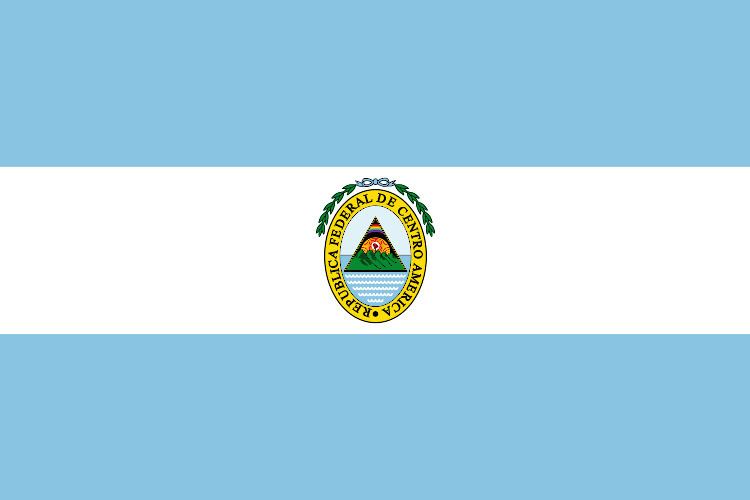 | ||
Capitals Similar Costa Rica, El Salvador, Honduras | ||
Federal republic of central america rep blica federal de centro am rica 1824 1839
The Federal Republic of Central America (Spanish: República Federal de Centroamérica), also called the United Provinces of Central America (Spanish: Provincias Unidas del Centro de América) in its first year of creation, was a sovereign state in Central America, which consisted of the territories of the former Captaincy General of Guatemala of New Spain. It existed from September 1821 to 1841, and was a republican democracy. It is also sometimes incorrectly referred to in English as the United States of Central America.
Contents
- Federal republic of central america rep blica federal de centro am rica 1824 1839
- Independence 18211822
- Absorption into the Empire of Mexico 18221823
- Reconstitution of the Federal Republic 18231840
- Dissolution of the union
- Politics
- Name and emblems
- Successor flags
- Later Central American federal unions
- References
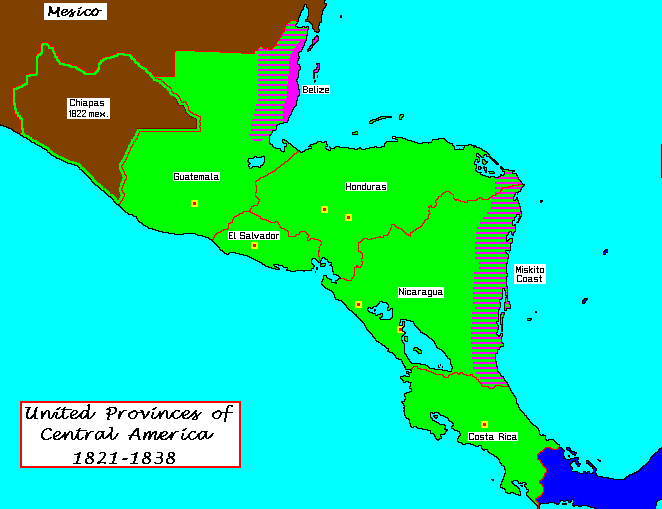
The republic consisted of the present-day states of Guatemala, El Salvador, Honduras, Nicaragua, and Costa Rica. (Panama was part of Bolivar's República de Colombia in 1821, Belize later became a British colony in 1862.) In the 1830s, an additional sixth state was added – Los Altos, with its capital in Quetzaltenango – occupying parts of what are now the western highlands of Guatemala and Chiapas state in southern Mexico. Maps and borders hardly existed at the time so locations are only approximate.

Shortly after Central America declared independence from the Spanish Empire, some of its countries were annexed by the First Mexican Empire in 1821 and then Central America formed the Federal Republic in 1823. From 1838 to 1840 the federation descended into civil war, with conservatives fighting against liberals and separatists fighting to secede. Without a sustained struggle for independence to cement a sense of national identity, the various political factions were unable to overcome their ideological differences and the federation dissolved after a series of bloody conflicts.
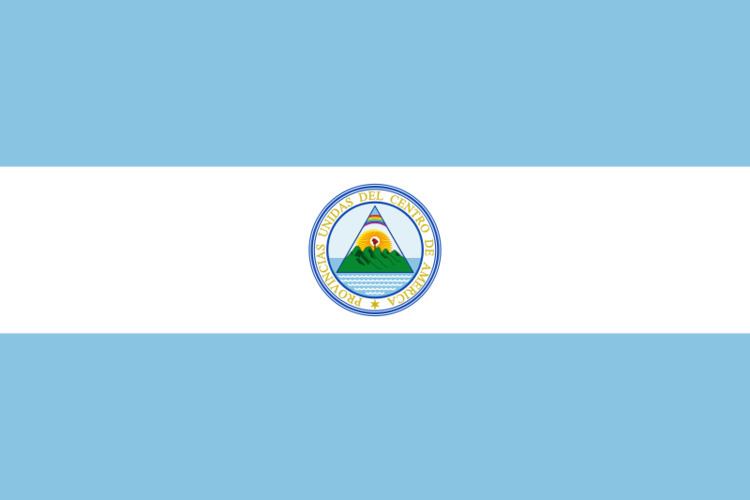
Independence 1821–1822
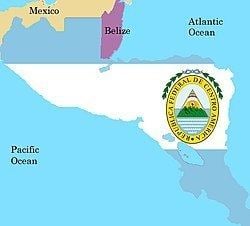
From the 16th century through 1821, Central America, apart from Panama, formed the Captaincy General of Guatemala within the Spanish Empire. In 1821 a congress of Central American Criollos in Guatemala City composed the Act of Independence of Central America to declare the region's independence from Spain, effective on 15 September of that year. The process was bloodless with no resistance from the Spanish authorities as the Governor General Brigadier Gabino Gaínza along with all the royal governors of the five provinces were retained in office as executive powers pending a full transition local rule. That date is still marked as independence day by most Central American nations.
Absorption into the Empire of Mexico, 1822–1823
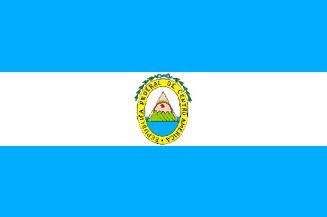
Independence proved short-lived, as local law-and-order broke down. Driven by regional rivalries, many localities refused to accept the newly formed federal powers in Guatemala—San Salvador, Comayagua, León, and Cartago were in open revolt. The ensuing anarchy prompted the land-owning wealthy and conservative class to advocate union with Mexico. On 25 January 1822 the Junta consultiva in Guatemala City voted for annexation. A few weeks later General Vicente Filísola, the envoy of Emperor Agustín de Iturbide of the First Mexican Empire arrived in Guatemala as the new ruler.

The annexation was controversial, with some seeing the Mexican constitution with its abolition of slavery and establishment of free trade as an improvement over the status quo. Central American liberals in San Salvador objected to this and refused to accept Filísola's authority. The army was ordered to quell dissent. In the case of Costa Rica, the country decided not to join the Mexican Empire as part of the resolutions upon conclusion of the Battle of Ochomogo (5 April 1823), which is considered as the first civil war of Costa Rica. After Iturbide abdicated (19 March 1823), Mexico became a republic (formally proclaimed on 1 November 1823) and offered to the previously annexed Central American provinces the right to determine their own destiny. Filísola turned over his power to the hastily formed National Constituent Assembly, which comprised representatives from each of the five provinces. On 1 July 1823 the Congress of Central America declared absolute independence from Spain, Mexico, and any other foreign nation, and established a republican system of government.
Reconstitution of the Federal Republic 1823–1840
The liberal-dominated Assembly elected Manuel José Arce as president but he soon turned against his own faction and dissolved the Assembly. San Salvador rose in revolt against federal authority. Honduras and Nicaragua joined the rebellion and Arce was deposed in 1829. The victors led by the Honduran Francisco Morazán took power and Morazán was proclaimed president in 1830. To appease liberal supporters, the capital was relocated from Guatemala City to San Salvador in 1831 but Morazán's hold on power was waning as conservatives regained control in the provinces.
The Assembly in 1838 adjourned with the declaration that the provinces were free to rule themselves as the Federal Republic dissolved. In 1839 Morazán was exiled as rebels from Guatemala, Honduras and Nicaragua entered San Salvador, evicting the governing institutions that held the region together.
Dissolution of the union
In practice, the federation faced insurmountable problems, and the union slid into civil war between 1838 and 1840. Its disintegration began when Nicaragua separated from the federation on November 5, 1838, followed by Honduras and Costa Rica (other sources give Nicaragua's secession date as April 30). Because of the chaotic nature of this period an exact date of disestablishment does not exist, but on May 31, 1838, the congress met to declare that the provinces were free to create their own independent republics. In reality, this merely legally acknowledged the process of disintegration that had already begun. The union effectively ended in 1840, by which time four of its five states had declared independence. The official end came only upon El Salvador's self-proclamation of the establishment of an independent republic in February 1841.
Politics
The liberal democratic project was strongly opposed by conservative factions allied with the Roman Catholic clergy and the wealthy landowners. Transportation and communication routes between the states were extremely deficient. The bulk of the population lacked any sense of commitment towards the broader federation, perhaps owing to their continued loyalty to the Roman Catholic Church in Spain.
The federal bureaucracy in Guatemala City proved ineffectual, and fears of Guatemalan domination of the union led to protests that resulted in the relocation of the capital to San Salvador in 1831. Wars soon broke out between various factions both in the federation and within individual states. The poverty and extreme political instability of the region prevented the proposed construction of an inter-oceanic canal (see Nicaragua Canal and Panama Canal), from which Central America could have obtained considerable economic benefits.
Name and emblems
Central American liberals had high hopes for the federal republic, which they believed would evolve into a modern, democratic nation, enriched by trade passing through it between the Atlantic and the Pacific oceans. These aspirations are reflected in the emblems of the federal republic: the flag shows a white band between two blue stripes, representing the land between two oceans. The coat of arms shows five mountains (one for each state) between two oceans, surmounted by a Phrygian cap, the emblem of the French Revolution.
The coat of arms on the nation's flag from 1823–1824 referred to the federation (in Spanish) as Provincias Unidas del Centro de América ("United Provinces of the Center of America"); however, its 1824 constitution, coat of arms, and flag called it República Federal de Centroamérica / Centro América ("Federal Republic of Central America").
The flag was introduced to the area by Commodore Louis-Michel Aury inspired by the Argentine flag. The term United Provinces was also used in Argentina's first title Provincias Unidas del Río de la Plata ("United Provinces of the River Plate")(Plata actually means silver in context). Commodore Aury established the first independent republic in Old Providence Island (Isla de Providencia) in 1818, off the coast of Nicaragua.
Successor flags
Today, all five successor nations’ flags retain the old federal motif of two outer blue bands bounding an inner white stripe (Costa Rica modified its flag significantly in 1848 by darkening the blue and adding a double-wide inner red band, in honor of the French tricolor). The short-lived sixth state of Los Altos voted to be annexed by Mexico as the state of Chiapas.
Later Central American federal unions
Despite the failure of a lasting political union, the sense of shared history and the hope for eventual reunification persist in the nations formerly in the union. Various attempts were made to reunite Central America in the nineteenth and early twentieth centuries, but none succeeded for any length of time:
